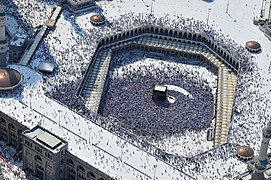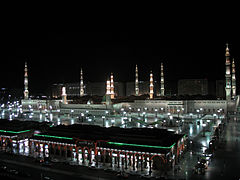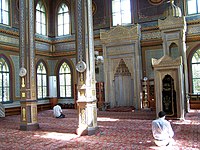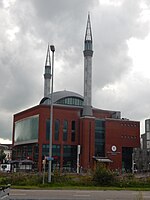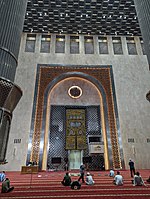Mosque
| Part ofa serieson |
| Islam |
|---|
 |
Amosque(/mɒsk/MOSK), also called amasjid(/ˈmæsdʒɪd,ˈmʌs-/MASS-jid,MUSS-),[note 1]is aplace of worshipforMuslims.[1]The term usually refers to a covered building, but can be any place whereIslamic prayersare performed, such as an outdoor courtyard.[2][3]
Originally, mosques were simple places of prayer for theearly Muslims,and may have been open spaces rather than elaborate buildings.[4]In the first stage ofIslamic architecture(650–750 CE), early mosques comprised open and closed covered spaces enclosed by walls, often withminarets,from which theIslamic call to prayerwas issued on a daily basis.[5]It is typical of mosque buildings to have a special ornamental niche (amihrab) set into the wall in the direction of the city ofMecca(theqibla), which Muslims must face during prayer,[1]as well as a facility for ritual cleansing (wudu).[1][6]The pulpit (minbar), from which public sermons (khutbah) are delivered on the event ofFriday prayer,was, in earlier times, characteristic of the central city mosque, but has since become common in smaller mosques.[7][1]To varying degrees, mosque buildings are designed so that there aresegregated spaces for men and women.[1]This basic pattern of organization has assumed different forms depending on the region, period, andIslamic denomination.[6]
In addition to being places of worship inIslam,mosques also serve as locations forfuneral servicesandfuneral prayers,marriages (nikah), vigils duringRamadan,business agreements, collection and distribution ofalms,and homeless shelters.[1][7]To this end, mosques have historically been multi-purpose buildings functioning as community centres, courts of law, andreligious schools.In modern times, they have also preserved their role as places of religious instruction and debate.[1][7]Special importance is accorded to, in descending order of importance:al-Masjid al-Haramin the city of Mecca, whereHajjandUmrahare performed; theProphet's Mosquein the city ofMedina,whereMuhammadis buried; andal-Aqsa Mosquein the city ofJerusalem,where Muslims believe thatMuhammad ascended to heaven to meet Godaround 621 CE.[1]There's a growing realization among scholars that the present-day perception of mosques doesn't fully align with their original concept. Early Islamic texts and practices highlight mosques as vibrant centers integral to Muslim communities, supporting religious, social, economic, and political affairs.[8]
During and after theearly Muslim conquests,mosques were established outside ofArabiain the hundreds; manysynagogues,churches,andtempleswereconverted into mosquesand thus influenced Islamic architectural styles over the centuries.[7]While most pre-modern mosques were funded by charitable endowments (waqf),[1]the modern-day trend of government regulation of large mosques has been countered by the rise of privately funded mosques, many of which serve as bases for different streams ofIslamic revivalismand social activism.[7]
Etymology
[edit]The word 'mosque' entered theEnglish languagefrom theFrenchwordmosquée,probably derived fromItalianmoschea(a variant of Italianmoscheta), from eitherMiddle Armenianմզկիթ(mzkit‘),MedievalGreek:μασγίδιον(masgídion), or Spanishmezquita,fromمسجد(meaning "site of prostration (in prayer)" and hence a place of worship), either fromNabataeanmasgĕdhā́or from ArabicArabic:سَجَدَ,romanized:sajada(meaning "toprostrate"), probably ultimately fromNabataean Arabicmasgĕdhā́orAramaicsĕghēdh.[9]
History
[edit]Origins
[edit]Islam was established in Arabia during the lifetime ofMuhammadin the 7th century CE.[10]Thefirst mosquein history could be either the sanctuary built around theKa'bahinMecca,known today asAl-Masjid al-Haram('The Sacred Mosque'), or theQuba MosqueinMedina,the first structure built by Muhammad upon hisemigration from Meccain 622CE,[11]both located in the Hejaz region in present-day Saudi Arabia.[12]
Other scholars reference Islamic tradition[13][14][15]and passages of the Quran,[16][17][18]according to which Islam as a religion precedes Muhammad, and includes previous prophets such as Abraham.[19]In Islamic tradition,Abrahamis credited with having built theKa'bahin Mecca, and consequently its sanctuary,Al-Masjid al-Haram,which is seen by Muslims as the first mosque that existed.[20][21][22][23]AhadithinSahih al-Bukharistates that the sanctuary of theKa'bahwas the first mosque on Earth, with the second mosque beingAl-AqsainJerusalem,[24]which is also associated with Abraham.[21]Since as early as 638 CE, the Sacred Mosque of Mecca has been expanded on several occasions to accommodate the increasing number of Muslims who either live in the area or make the annual pilgrimage known asHajjto the city.[25]
Either way, after the Quba Mosque,Muhammad went on to establish another mosque in Medina,which is now known asAl-Masjid an-Nabawi('The Prophet's Mosque'). Built on the site of his home, Muhammad participated in the construction of the mosque himself and helped pioneer the concept of the mosque as the focal point of the Islamic city.[26]The Prophet's Mosque is considered by some scholars ofIslamic architectureto be the first mosque.[27][28]The mosque had a roof supported by columns made of palm tree trunks[29]and it included a large courtyard, a motif common among mosques built since then.[26]Rebuilt and expanded over time,[30]it soon became a largerhypostylestructure.[28]It probably served as a model for the construction of early mosques elsewhere.[27][28][29]It introduced some of the features still common in today's mosques, including the niche at the front of the prayer space known as themihrab(first added in theUmayyad period)[30]and the tiered pulpit called theminbar.[31]
-
Aerial view of theSacred Mosque (Al-Masjid Al-Ḥarām)ofMeccainSaudi Arabia,the largest mosque andholiest site in Islam,with theKaabain the center (2010 photo)
-
TheProphet's Mosque (al-Masjid an-Nabawi)inMedina,Islam's second holiest site
-
Masjid al-Qiblatayn(Mosque of the twoQiblahs) in Medina
-
TheAl-Aqsa MosqueinJerusalem,Islam's third holiest site
Diffusion and evolution
[edit]
TheUmayyad Caliphatewas particularly instrumental in spreading Islam and establishing mosques within theLevant,as the Umayyads constructed among the most revered mosques in the region —Al-Aqsa MosqueandDome of the RockinJerusalem,and theUmayyad MosqueinDamascus.[32]The designs of the Dome of the Rock and the Umayyad Mosque were influenced byByzantine architecture,a trend that continued much later with the rise of theOttoman Empire.[33]
TheGreat Mosque of Kairouanin present-dayTunisiawas the first mosque built in theMaghreb(northwest Africa), with its present form (dating from the ninth century) serving as a model for other Islamic places of worship in the Maghreb. It was the first in the region to incorporate a squareminaret,which was characteristic of later Maghrebi mosques, and includesnavesakin to abasilica.[34][35]Those features can also be found inAndalusimosques, including theGreat Mosque of Cordoba,as they tended to reflect the architecture of theMoorsinstead of theirVisigothpredecessors.[35]Still, some elements ofVisigothic architecture,likehorseshoe arches,were infused into the mosque architecture of Spain and the Maghreb.[36]

Muslim empires were instrumental in the evolution and spread of mosques. Although mosques were first established in India during the seventh century, they were not commonplace acrossthe subcontinentuntil the arrival of theMughalsin the 16th and 17th centuries. Reflecting theirTimuridorigins,Mughal-stylemosques includedonion domes,pointed arches,and elaborate circular minarets, features common in thePersianandCentral Asian styles.[37]TheJama MasjidinDelhiand theBadshahi MosqueinLahore,built in a similar manner in the mid-17th century,[38]remain two of the largest mosques on the Indian subcontinent.[39]
The first mosque inEast Asiawas established in the eighth century inXi'an.TheGreat Mosque of Xi'an,whose current building dates from the 18th century, does not replicate the features often associated with mosques elsewhere.[40]Minarets were initially prohibited by the state.[41]Following traditionalChinese architecture,the Great Mosque of Xi'an, like many other mosques in eastern China, resembles apagoda,with a green roof instead of the yellow roof common on imperial structures in China. Mosques in western China were more likely to incorporate elements, like domes and minarets, traditionally seen in mosques elsewhere.[40]

A similar integration of foreign and local influences could be seen on theIndonesianislands ofSumatraandJava,where mosques, including theDemak Great Mosque,were first established in the 15th century.[42]Early Javanese mosques took design cues fromHindu,Buddhist,and Chinese architectural influences, with tall timber, multi-level roofs similar to the pagodas ofBalinese Hindu temples;the ubiquitous Islamic dome did not appear in Indonesia until the 19th century.[41][43]In turn, the Javanese style influenced the styles of mosques in Indonesia'sAustronesianneighbors—Malaysia,Brunei,and the Philippines.[42]
Several of the early mosques in the Ottoman Empire were originally churches or cathedrals from theByzantine Empire,with theHagia Sophia(one of those converted cathedrals) informing the architecture of mosques from after theOttoman conquest of Constantinople.[44]The Ottomans developedtheir own architectural stylecharacterized by large central domes (sometimes surrounded by multiple smaller domes), pencil-shaped minarets, and open façades.[45]

Mosques from the Ottoman period are still scattered acrossEastern Europe,but the most rapid growth in the number of mosques in Europe has occurred within the past century as more Muslims have migrated to the continent. Many major European cities are home to mosques, like theGrand Mosque of Paris,that incorporate domes, minarets, and other features often found with mosques in Muslim-majority countries.[46]The first mosque in North America was founded byAlbanian Americansin 1915, but the continent's oldest surviving mosque, theMother Mosque of America,was built in 1934.[47]As in Europe, the number of American mosques has rapidly increased in recent decades as Muslim immigrants, particularly fromSouth Asia,have come in the United States. Greater than forty percent of mosques in the United States were constructed after 2000.[48]
Inter-religious conversion
[edit]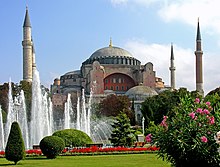
According to earlyMuslim historians,towns that surrendered without resistance and made treaties with the Muslims were allowed to retain their churches and the towns captured by Muslims had many of their churches converted to mosques.[49]One of the earliest examples of these kinds of conversions was inDamascus,Syria, where in 705UmayyadcaliphAl-Walid Ibought the church ofSt. Johnfrom theChristiansand had it rebuilt as a mosque in exchange for building a number of new churches for the Christians in Damascus. Overall,Abd al-Malik ibn Marwan(Al-Waleed's father) is said to have transformed 10 churches in Damascus into mosques.[50]
The process of turning churches into mosques were especially intensive in the villages where most of the inhabitantsconvertedto Islam.[citation needed]TheAbbasidcaliphal-Ma'munturned many churches into mosques.Ottoman Turksconverted nearly all churches, monasteries, and chapels inConstantinople,including the famousHagia Sophia,into mosques immediately aftercapturing the city in 1453.In some instances mosques have been established on the places ofJewishor Christian sanctuaries associated withBiblicalpersonalities who were also recognized by Islam.[51]
Mosques have also been converted for use by other religions, notably in southern Spain, following the conquest of the Moors in 1492.[52]The most prominent of them is theGreat Mosque of Cordoba,itself constructed on the site of a church demolished during the period of Muslim rule. Outside of theIberian Peninsula,such instances also occurred in southeastern Europe once regions were no longer under Muslim rule.
Religious functions
[edit]Prayers
[edit]There are two holidays (Eids) in theIslamic calendar:ʿĪd al-FiṭrandʿĪd al-Aḍḥā,during which there are special prayers held at mosques in the morning. TheseEid prayersare supposed to be offered in large groups, and so, in the absence of an outdoorEidgah,a large mosque will normally host them for their congregants as well as the congregants of smaller local mosques. Some mosques will even rentconvention centersor other large public buildings to hold the large number of Muslims who attend. Mosques, especially those in countries where Muslims are the majority, will also host Eid prayers outside in courtyards,town squaresor on the outskirts of town in anEidgah.[53][54]
Ramadan
[edit]
Islam's holiest month,Ramaḍān,is observed through many events. As Muslims mustfastduring the day during Ramadan, mosques will hostIfṭārdinners after sunset and the fourth required prayer of the day, that isMaghrib.Food is provided, at least in part, by members of the community, thereby creating dailypotluckdinners. Because of the community contribution necessary to serveiftardinners, mosques with smaller congregations may not be able to host theiftardinners daily. Some mosques will also holdSuḥūrmeals beforedawnto congregants attending the first required prayer of the day,Fajr.As with iftar dinners, congregants usually provide the food for suhoor, although able mosques may provide food instead. Mosques will often invite poorer members of the Muslim community to share in beginning and breaking the fasts, as providingcharityduring Ramadan is regarded in Islam as especially honorable.[55]
Following the last obligatory daily prayer (ʿIshāʾ) special, optionalTarāwīḥprayers are offered in larger mosques. During each night of prayers, which can last for up to two hours each night, usually one member of the community who has memorized the entire Quran (aHafiz) will recite a segment of the book.[56]Sometimes, several such people (not necessarily of the local community) take turns to do this. During the last ten days of Ramadan, larger mosques will host all-night programs to observeLaylat al-Qadr,the night Muslims believe that Muhammad first received Quranic revelations.[56]On that night, betweensunsetandsunrise,mosques employ speakers to educate congregants in attendance about Islam. Mosques or the community usually provide meals periodically throughout the night

During the last ten days ofRamadan,larger mosques within the Muslim community will hostIʿtikāf,a practice in which at least one Muslim man from the community must participate. Muslims performing itikaf are required to stay within the mosque for ten consecutive days, often in worship or learning about Islam. As a result, the rest of the Muslim community is responsible for providing the participants with food, drinks, and whatever else they need during their stay.[56]
Charity
[edit]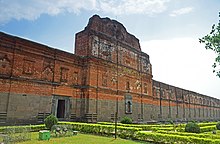
The third of theFive Pillars of Islamstates that Muslims are required to give approximately one-fortieth of their wealth to charity asZakat.[57]Since mosques form the center of Muslim communities, they are where Muslims go to both givezakatand, if necessary, collect it. Before the holiday ofEid ul-Fitr,mosques also collect a specialzakatthat is supposed to assist in helping poor Muslims attend the prayers and celebrations associated with the holiday.
Frequency of attendance
[edit]The frequency by which Muslims attend mosque services vary greatly around the world. In some countries, weekly attendance at religious services is common among Muslims while in others, attendance is rare. A study of American Muslims did not find differences in mosque attendance by gender or age.[58]
Architecture
[edit]Styles
[edit]
Arab-planorhypostylemosques are the earliest type of mosques, pioneered under the Umayyad Dynasty. These mosques have square or rectangular plans with an enclosed courtyard (sahn) and covered prayer hall. Historically, in the warm Middle Eastern andMediterranean climates,the courtyard served to accommodate the large number of worshippers during Friday prayers. Most early hypostyle mosques had flat roofs on prayer halls, which required the use of numerouscolumnsandsupports.[51]One of the most notable hypostyle mosques is the Great Mosque of Cordoba in Spain, the building being supported by over 850 columns.[74]Frequently, hypostyle mosques have outerarcades(riwaq) so that visitors can enjoy the shade. Arab-plan mosques were constructed mostly under the Umayyad and Abbasid dynasties. The simplicity of the Arab plan limited the opportunities for further development, the mosques consequently losing popularity.[51]

The first departure within mosque design started in Persia (Iran). ThePersianshad inherited a richarchitectural legacyfrom the earlier Persian dynasties, and they began incorporating elements from earlierParthianandSassaniddesigns into their mosques, influenced by buildings such as thePalace of Ardashirand theSarvestan Palace.[75]Thus,Islamic architecturewitnessed the introduction of such structures as domes and large, arched entrances, referred to asiwans.DuringSeljuq rule,asIslamic mysticismwas on the rise, thefour-iwanarrangement took form. The four-iwan format, finalized by the Seljuqs, and later inherited by theSafavids,firmly established the courtyard façade of such mosques, with the towering gateways at every side, as more important than the actual buildings themselves.[75]They typically took the form of a square-shaped central courtyard with large entrances at each side, giving the impression of gateways to the spiritual world.[76]The Persians also introducedPersian gardensinto mosque designs. Soon, a distinctlyPersian styleof mosques started appearing that would significantly influence the designs of laterTimurid,and alsoMughal,mosque designs.

The Ottomans introduced central dome mosques in the 15th century. These mosques have a large dome centered over the prayer hall. In addition to having a large central dome, a common feature is smaller domes that exist off-center over the prayer hall or throughout the rest of the mosque, where prayer is not performed.[77]This style was heavily influenced by Byzantine architecture with its use of large central domes.[51]
Islam forbidsfigurative art,on the grounds that the artist must not imitate God's creation. Mosques are, therefore, decorated withabstract patternsand beautiful inscriptions. Decoration is often concentrated around doorways and themiḥrāb.Tiles are used widely in mosques. They lend themselves to pattern-making, can be made with beautiful subtle colors, and can create a cool atmosphere, an advantage in the hot Arab countries. Quotations from theQuranoften adorn mosque interiors. These texts are meant to inspire people by their beauty, while also reminding them of the words of Allah.[78]
Prayer hall
[edit]The prayer hall, also known as themuṣallá(Arabic:مُصَلَّى), rarely has furniture; chairs and pews are generally absent from the prayer hall so as to allow as many worshipers as possible to line the room.[79]Some mosques haveIslamic calligraphyand Quranic verses on the walls to create a more religious atmosphere for worshippers.[56]
Often, a limited part of the prayer hall is sanctified formally as amasjidin thesharīʿahsense (although the termmasjidis also used for the larger mosque complex as well). Once designated, there are onerous limitations on the use of this formally designatedmasjid,and it may not be used for any purpose other than worship; restrictions that do not necessarily apply to the rest of the prayer area, and to the rest of the mosque complex (although such uses may be restricted by the conditions of thewaqfthat owns the mosque).[80]
In many mosques, especially the early congregational mosques, the prayer hall is built in thehypostyleform (the roof held up by a multitude of columns).[81]One of the finest examples of the hypostyle-plan mosques is theGreat Mosque of KairouaninTunisia.[82]
Usually opposite the entrance to the prayer hall is theqiblawall (the direction ofMecca,and thus the direction towards whichMuslimsshould face for prayer), the visually emphasized area inside the prayer hall. Theqiblawall should, in a properly oriented mosque, be set perpendicular to a line leading toMecca,where theKaabais located.[83]Congregants pray in rows parallel to the qiblah wall and thus arrange themselves so they face Mecca. In theqiblawall, usually at its center, is themiḥrāb,a niche or depression indicating the direction of Mecca. Usually themihrabis not occupied by furniture either. A raisedminbar(pulpit) is located to the right side of themihrabfor akhaṭīb(preacher), or some other speaker, to offer akhuṭbah(sermon) during the ritual Friday prayers.
Themihrabserves as the location where theimamormullahleads the five daily prayers on a regular basis.[84]Left to themihrab,in the front left corner of the mosque, sometimes there is akursu(Turkish:kürsü,Bosnian:ćurs/ћурс), a small elevated plateau (rarely with a chair or other type of seat) used for less formal preaching and speeches.
-
Main prayer hall with hypostyle in theGreat Mosque of Kairouan,Tunisia
-
Wooden prayer hall of theJärvenpää Mosque,a historic mosque used by theFinnish Tatarcommunity, inJärvenpää,Finland
Women's prayer hall
[edit]Women who pray in mosques are separated from men.Their part for prayer is calledmaqfil[85](Bosnian:makfil/макфил). It is located above the main prayer hall, elevated in the background as stairs-separated gallery or plateau (surface-shortened to the back relative to the bottom main part). It usually has a perforated fence at the front, through which theimamormullahand the other male worshippers in the main hall can be partially seen.
Mihrab
[edit]
Amiḥrāb,also spelled asmehrabis a semicircularnichein the wall of a mosque that faces theqiblah(i.e. the "front" of the mosque); the imam stands in this niche and leads prayer. Given that the imam typically stands alone in the frontmost row, this niche's practical effect is to save unused space.[86]Theminbaris apulpitfrom which the Friday sermon is delivered. While theminbarof Muhammad was a simple chair, later it became larger and attracted artistic attention. Some remained made of wood, albeit exquisitely carved, while others were made of marble and featuredfriezes.[87]
Minarets
[edit]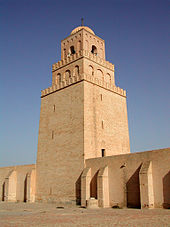
A common feature in mosques is the minaret, the tall, slender tower that usually is situated at one of the corners of the mosque structure. The top of the minaret is always the highest point in mosques that have one, and often the highest point in the immediate area.

The origin of the minaret and its initial functions are not clearly known and have long been a topic of scholarly discussion.[88][89]The earliest mosques lacked minarets, and the call to prayer was often performed from smaller structures or elevated platforms.[90][91][92]The early Muslim community of Medina gave the call to prayer from the doorway or the roof of the house ofMuhammad,which doubled as a place for prayer.[93]The first confirmed minarets in the form of towers date from the early 9th century under Abbasid rule and they did not become a standard feature of mosques until the 11th century.[94][95]These first minaret towers were placed in the middle of the wall opposite the qibla wall.[96]Among them, the minaret of the Great Mosque of Kairouan in Tunisia, dating from 836, is well-preserved and is one of the oldest surviving minarets in the world today.[97][95][98]
Before the five required daily prayers, aMu’adhdhin(Arabic:مُـؤَذِّن) calls the worshippers to prayer from the minaret. In many countries like Singapore where Muslims are not the majority, mosques are prohibited from loudly broadcasting theAdhān(Arabic:أَذَان,Call to Prayer), although it is supposed to be said loudly to the surrounding community. Theadhanis required before every prayer. Nearly every mosque assigns amuezzinfor each prayer to say theadhanas it is a recommended practice orSunnah(Arabic:سُـنَّـة) of the Islamic prophet Muhammad. At mosques that do not have minarets, theadhanis called instead from inside the mosque or somewhere else on the ground.[56]TheIqâmah(Arabic:إِقَـامَـة), which is similar to theadhanand proclaimed right before the commencement of prayers, is usually not proclaimed from the minaret even if a mosque has one.
Domes
[edit]
The domes, often placed directly above the main prayer hall, may signify the vaults of theheavenand sky.[99]As time progressed, domes grew, from occupying a small part of the roof near the mihrab to encompassing the whole roof above the prayer hall. Although domes normally took on the shape of a hemisphere, the Mughals in India popularizedonion-shaped domesin South Asia which has gone on to become characteristic of the Arabic architectural style of dome.[100]Some mosques have multiple, often smaller, domes in addition to the main large dome that resides at the center. The domes of Turkish-style mosques are influenced by Byzantine architecture, particularly from the 15th century onwards as the Balkans and Constantinople became part of the Ottoman Empire.
Ablution facilities
[edit]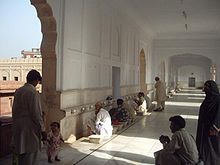
Asritual purificationprecedes all prayers, mosques often haveablutionfountains or other facilities for washing in their entryways or courtyards. Worshippers at much smaller mosques often have to use restrooms to perform their ablutions. In traditional mosques, this function is often elaborated into a freestanding building in the center of a courtyard.[74]This desire for cleanliness extends to the prayer halls where shoes are disallowed to be worn anywhere other than the cloakroom. Thus, foyers with shelves to put shoes and racks to hold coats are commonplace among mosques.[79]
Contemporary features
[edit]Modern mosques have a variety of amenities available to their congregants. As mosques are supposed to appeal to the community, they may also have additional facilities, fromhealth clinicsandclubs(gyms) tolibrariestogymnasiums,to serve the community.[citation needed]
Symbols
[edit]Certain symbols are represented in a mosque's architecture to allude to different aspects of the Islamic religion. One of these feature symbols is the spiral. The "cosmic spiral" found in designs and on minarets is a references to heaven as it has "no beginning and no end".[101]Mosques also often have floral patterns or images of fruit and vegetables. These are allusions to the paradise after death.[101]
Rules and etiquette
[edit]Prayer leading
[edit]Appointment of a prayer leader is considered desirable, but not always obligatory.[102]The permanent prayer leader (imam) must be a free honest individual and is authoritative in religious matters.[102]In mosques constructed and maintained by the government, the prayer leader is appointed by the ruler;[102]in private mosques, appointment is made by members of the congregation throughmajority voting.According to theHanafischoolof Islamic jurisprudence, the individual who built the mosque has a stronger claim to the title of imam, but this view is not shared by the other schools.[102]
Leadership at prayer falls into three categories, depending on the type of prayer: five daily prayers, Friday prayer, or optional prayers.[102]According to the Hanafi andMalikischool of Islamic jurisprudence, appointment of a prayer leader for Friday service is mandatory because otherwise the prayer is invalid. TheShafi'iandHanbalischools argue that the appointment is not necessary and the prayer is valid as long as it is performed in a congregation. A slave may lead a Friday prayer, but Muslim authorities disagree over whether the job can be done by a minor.[102]An imam appointed to lead Friday prayers may also lead at the five daily prayers;Muslim scholarsagree to the leader appointed for five daily services may lead the Friday service as well.[102]
All Muslim authorities hold the consensus opinion that only men may lead prayer for men.[102]Nevertheless, women prayer leaders are allowed to lead prayer in front of all-female congregations.[103]
Cleanliness
[edit]
All mosques have rules regarding cleanliness, as it is an essential part of the worshippers' experience. Muslims before prayer are required to cleanse themselves in an ablution process known aswudu.Shoes must not be worn inside the carpeted prayer hall. Some mosques will also extend that rule to include other parts of the facility even if those other locations are not devoted to prayer. Congregants and visitors to mosques are supposed to be clean themselves. It is also undesirable to come to the mosque after eating something that smells, such as garlic.[104]
Dress
[edit]Islam requires that its adherents wearclothesthat portraymodesty.Men are supposed to come to the mosque wearing loose and clean clothes that do not reveal the shape of the body. Likewise, it is recommended that women at a mosque wear loose clothing that covers to the wrists and ankles, and cover their heads with aḤijāb(Arabic:حِجاب), or other covering. Many Muslims, regardless of their ethnic background, wear Middle Eastern clothing associated with Arabic Islam to special occasions and prayers at mosques.[56]
Concentration
[edit]As mosques are places of worship, those within the mosque are required to remain respectful to those in prayer. Loud talking within the mosque, as well as discussion of topics deemed disrespectful, is forbidden in areas where people are praying. In addition, it is disrespectful to walk in front of or otherwise disturb Muslims in prayer.[105]The walls within the mosque have few items, except for possibly Islamic calligraphy, so Muslims in prayer are not distracted.[106]Muslims are also discouraged from wearing clothing with distractingimagesandsymbolsso as not to divert the attention of those standing behind them during prayer. In many mosques, even the carpeted prayer area has no designs, its plainness helping worshippers to focus.
Gender separation
[edit]
There is nothing written in the Qur'an about the issue of space in mosques and gender separation. Traditional rules have segregated women and men. By traditional rules, women are most often told to occupy the rows behind the men. In part, this was a practical matter as the traditional posture for prayer – kneeling on the floor, head to the ground – made mixed-gender prayer uncomfortably revealing for many women and distracting for some men. Traditionalists try to argue that Muhammad preferred women to pray at home rather than at a mosque, and they cite aḥadīthin which Muhammad supposedly said: "The best mosques for women are the inner parts of their houses," although women were active participants in the mosque started by Muhammad. Muhammad told Muslims not to forbid women from entering mosques. They are allowed to go in.[107]The second Sunni caliph 'Umarat one time prohibited women from attending mosques especially at night because he feared they might be sexually harassed or assaulted by men, so he required them to pray at home.[108]Sometimes a special part of the mosque was railed off for women; for example, the governor of Mecca in 870 had ropes tied between the columns to make a separate place for women.[51]
Many mosques today will put the women behind a barrier or partition or in another room. Mosques inSouthandSoutheast Asiaput men and women in separate rooms, as the divisions were built into them centuries ago. In nearly two-thirds of American mosques, women pray behind partitions or in separate areas, not in the main prayer hall; some mosques do not admit women at all due to the lack of space and the fact that some prayers, such as the Friday Jumuʻah, are mandatory for men but optional for women.[109]Although there are sections exclusively for women and children, the Grand Mosque in Mecca is desegregated.[110]
Non-Muslim inclusion
[edit]
Under most interpretations ofsharia,non-Muslims are permitted to enter mosques provided that they respect the place and the people inside it.[additional citation(s) needed]A dissenting opinion and minority view is presented by followers of theMalikischool of Islamic jurisprudence, who argue that non-Muslims may not be allowed into mosques under any circumstances.[102]
The Quran addresses the subject of non-Muslims, and particularlypolytheists,in mosques in two verses in its ninth chapter,Sura At-Tawba.The seventeenth verse of the chapter prohibits those whojoin gods with Allah—polytheists—from maintaining mosques:
It is not for the polytheists to maintain the mosques of Allah while they openly profess disbelief. Their deeds are void, and they will be in the Fire forever.
The twenty-eighth verse of the same chapter is more specific as it only considers polytheists in theMasjid al-Haramin Mecca:
O believers! Indeed, the polytheists are ˹spiritually˺ impure, so they should not approach the Sacred Mosque after this year. If you fear poverty, Allah will enrich you out of His bounty, if He wills. Surely, Allah is All-Knowing, All-Wise.
According toAhmad ibn Hanbal,these verses were followed to the letter at the times of Muhammad, whenJewsand Christians, consideredmonotheists,were still allowed toAl-Masjid Al-Haram.The Umayyad caliphUmar IIlater forbade non-Muslims from entering mosques, and his ruling remains in practice in present-day Saudi Arabia.[51]Today, the decision on whether non-Muslims should be allowed to enter mosques varies. With few exceptions, mosques in the Arabian Peninsula as well as Morocco do not allow entry to non-Muslims. For example, the Hassan II Mosque in Casablanca is one of only two mosques in Morocco currently open to non-Muslims.[111]
There are many other mosques in the West and Islamic world which non-Muslims are welcome to enter. Most mosques in the United States, for example, report receiving non-Muslim visitors every month. Many mosques throughout the United States welcome non-Muslims as a sign of openness to the rest of the community as well as to encourage conversions to Islam.[112][113]
In modern-day Saudi Arabia, the Grand Mosque and all of Mecca are open only to Muslims. Likewise, Al-Masjid Al-Nabawi and the city ofMedinathat surrounds it are also off-limits to those who do not practice Islam.[114]For mosques in other areas, it has most commonly been taken that non-Muslims may only enter mosques if granted permission to do so by Muslims, and if they have a legitimate reason. All entrants regardless ofreligious affiliationare expected to respect the rules anddecorumfor mosques.[56]
In modern Turkey, non-Muslim tourists are allowed to enter any mosque, but there are some strict rules. Visiting a mosque is allowed only between prayers; visitors are required to wear long trousers and not to wear shoes, women must cover their heads; visitors are not allowed to interrupt praying Muslims, especially by taking photos of them; no loud talk is allowed; and no references to other religions are allowed (no crosses on necklaces, no cross gestures, etc.) Similar rules apply to mosques in Malaysia, where larger mosques that are also tourist attractions (such as theMasjid Negara) provide robes and headscarves for visitors who are deemed inappropriately attired.[115]
In certain times and places, non-Muslims were expected to behave a certain way in the vicinity of a mosque: in some Moroccan cities, Jews were required to remove their shoes when passing by a mosque;[116]in 18th-century Egypt, Jews and Christians had to dismount before several mosques in veneration of their sanctity.[117][better source needed]
The association of the mosque with education remained one of its main characteristics throughout history,[118]and the school became an indispensable appendage to the mosque. From the earliest days of Islam, the mosque was the center of the Muslim community, a place for prayer, meditation, religious instruction, political discussion, and a school. Anywhere Islam took hold, mosques were established, and basic religious and educational instruction began.[119]
Role in contemporary society
[edit]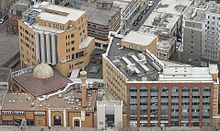
Political mobilization
[edit]The late 20th century saw an increase in the number of mosques used for political purposes. While some governments in the Muslim world have attempted to limit the content of Friday sermons to strictly religious topics, there are also independent preachers who deliverkhutbasthat address social and political issues, often in emotionally charged terms. Common themes include social inequalities, necessity ofjihadin the face of injustice, and the universal struggle between good and evil.[1]In Islamic countries like Bangladesh, Pakistan, Iran, and Saudi Arabia, political subjects are preached by imams at Friday congregations on a regular basis.[121]Mosques often serve as meeting points for political opposition in times of crisis.[1]
Countries with a minority Muslim population are more likely than Muslim-majority countries of theGreater Middle Eastto use mosques as a way to promote civic participation.[122]Studies of US Muslims have consistently shown a positive correlation between mosque attendance and political involvement. Some of the research connects civic engagement specifically with mosque attendance for social and religious activities other than prayer.[123]American mosques hostvoter registrationand civic participation drives that promote involving Muslims, who are often first- or second-generation immigrants, in the political process. As a result of these efforts as well as attempts at mosques to keep Muslims informed about the issues facing theMuslim community,regular mosque attendants are more likely to participate inprotests,signpetitions,and otherwise be involved in politics.[122]Research on Muslim civic engagement in other Western countries "is less conclusive but seems to indicate similar trends".[123]
Role in violent conflicts
[edit]
As they are considered important to the Muslim community, mosques, like other places of worship, can be at the heart of social conflicts. TheBabri Mosquein India was the subject of such a conflict up until the early 1990s when it was demolished. Before a mutual solution could be devised, the mosque was destroyed on December 6, 1992, as the mosque was built byBaburallegedly on the site of a previousHindu templemarking the birthplace ofRama.[124]The controversy surrounded the mosque was directly linked torioting in Bombay(present-dayMumbai) as well asbombings in 1993that killed 257 people.[125]
Bombings in February 2006 andJune 2007seriously damaged Iraq'sal-Askari Mosqueand exacerbated existing tensions. Other mosque bombings in Iraq, both before and after the February 2006 bombing, have been part of the conflict between the country's groups of Muslims. In June 2005, asuicide bombingkilled at least 19 people at an AfghanShiamosque near Jade Maivand.[126]In April 2006,two explosionsoccurred at India's Jama Masjid.[127]Following the al-Askari Mosque bombing in Iraq, imams and other Islamic leaders used mosques andFriday prayersas vehicles to call for calm and peace in the midst of widespread violence.[128]
A study 2005 indicated that while support for suicide bombings is not correlated with personal devotion to Islam among Palestinian Muslims, it is correlated with mosque attendance because "participating in communal religious rituals of any kind likely encourages support for self-sacrificing behaviors that are done for the collective good."[129]
Following theSeptember 11 attacks,several American mosques were targeted in attacks ranging from simplevandalismtoarson.[130]Furthermore, theJewish Defense Leaguewas suspected of plotting to bomb the King Fahd Mosque inCulver City, California.[131]Similar attacks occurred throughout the United Kingdom following the7 July 2005 London bombings.Outside the Western world, in June 2001, theHassan Bek Mosquewas the target of vandalism and attacks by hundreds of Israelis after a suicide bomber killed 19 people in a night club in Tel Aviv.[132][133][134]Although mosquegoing is highly encouraged for men, it is permitted to stay at home when one feels at risk from Islamophobic persecution.[135]
Saudi influence
[edit]Although the Saudi involvement in Sunni mosques around the world can be traced back to the 1960s, it was not until later in the 20th century that the government of Saudi Arabia became a large influence in foreign Sunni mosques.[136]Beginning in the 1980s, the Saudi Arabian government began to finance the construction of Sunni mosques in countries around the world. An estimatedUS$45 billion has been spent by the Saudi Arabian government financing mosques and Sunni Islamic schools in foreign countries.Ain al-Yaqeen,a Saudi newspaper, reported in 2002 that Saudi funds may have contributed to building as many as 1,500 mosques and 2,000 other Islamic centers.[137]
Saudi citizens have also contributed significantly to mosques in theIslamic world,especially in countries where they see Muslims as poor and oppressed. Following the fall of the Soviet Union, in 1992, mosques in war-torn Afghanistan saw many contributions from Saudi citizens.[136]The King Fahd Mosque in Culver City, California and the Islamic Cultural Center of Italy inRomerepresent two of Saudi Arabia's largest investments in foreign mosques as former Saudi kingFahd bin Abdul Aziz al-Saudcontributed US$8 million[136]and US$50 million[138]to the two mosques, respectively.
Political controversy
[edit]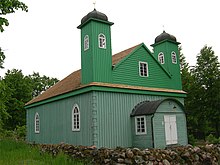
In the western world, and in the United States in particular, anti-Muslim sentiment and targeted domestic policy has created challenges for mosques and those looking to build them. There has been government and police surveillance of mosques in the US[139]and local attempts to ban mosques and block constructions,[140]despite data showing that in fact, most Americans oppose banning the building of mosques (79%) and the surveillance of U.S. mosques (63%) as shown in a 2018 study done by the Institute for Social Policy and Understanding.[141][clarification needed]
Since 2017,Chinese authoritieshave destroyed or damaged two-thirds of themosquesin China'sXinjiangprovince.[142]Ningxiaofficials were notified on 3 August 2018 that theWeizhou Grand Mosquewould be forcibly demolished because it had not received the proper permits before construction.[143][144][145]Officials in the town said that the mosque had not been given proper building permits, because it is built in aMiddle Easternstyle and includes numerousdomesandminarets.[143][144]The residents of Weizhou alarmed each other throughsocial mediaand finally stopped the mosque destruction by public demonstrations.[144]
See also
[edit]Notes
[edit]- ^Arabic:مَسْجِد[ˈmasdʒid](lit. 'place ofritual prostration')
- ^Survey was conducted in 2016, not 2009–2012.
- ^Survey was only conducted in the southern five provinces.
- ^Survey was conducted in 2013, not 2009–2012. Sample was taken from entire population of Yemen, which is approximately 99% Muslim.
- ^Survey was conducted in 2015, not 2009–2012.
- ^Survey was conducted in 2016, not 2009–2012.
- ^Survey was conducted in 2008, not 2009–2012.
- ^Survey was conducted in 2015, not 2009–2012.
- ^Survey was conducted in 2008, not 2009–2012.
- ^Survey was conducted in 2013, not 2009–2012. Sample was taken from entire population of Libya, which is approximately 97% Muslim.
- ^Survey was conducted in 2016, not 2009–2012.
- ^Survey was conducted in 2008, not 2009–2012.
- ^Survey was conducted in 2008, not 2009–2012.
- ^Survey was conducted in 2017, not 2009–2012.
- ^Survey was conducted in 2017, not 2009–2012.
References
[edit]Citations
[edit]- ^abcdefghijkJohn L. Esposito, ed. (2014)."Mosque".The Oxford Dictionary of Islam.Oxford University Press. Archived fromthe originalon December 25, 2017.
- ^Longhurst, Christopher E; Theology of a Mosque: The Sacred Inspiring Form, Function and Design in Islamic Architecture, Lonaard Journal. Mar 2012, Vol. 2 Issue 8, p3-13. 11p. "Since submission to God is the essence of divine worship, the place of worship is intrinsic to Islam's self-identity. This 'place' is not a building per se but what is evidenced by the etymology of the word 'mosque' which derives from the Arabic 'masjid' meaning 'a place of sujud (prostration).'
- ^Colledge, R. (1999). The mosque. In: Mastering World Religions. Macmillan Master Series. Palgrave, London.https://doi.org/10.1007/978-1-349-14329-0_16"A mosque is a building where Muslims bow before Allah to show their submission to His will. It is not necessary to have a building to do this. Muhammad said that 'Wherever the hour of prayer overtakes you, you shall perform the prayer. That place is the mosque'. In his early days in Makkah there was no mosque, so he and his friends would pray anywhere."
- ^Grabar 1969,p. 34: "The main characteristic, then, of this first stage was the creation of a space which served exclusively Muslim purposes and which, in cities that were entirely Muslim, existed on two separate levels of exclusivity. The word masjid is always associated with these spaces, but it does not yet possess any formal structure nor does it have any precise function other than that of excluding non-Muslims."
- ^Grabar 1969,p. 34-35: "A second stage occurred between 650 and 750. To my knowledge, twenty-seven masjids from this period are archaeologically definable… All mosques had a certain relationship between open and closed covered spaces. The problems posed by this relationship pertain primarily to the history of art, except on one point, which is the apparent tendency to consider the covered parts as the bayt al-salat, i.e. place of prayer, and the rest of the building as an overflow area for prayer. All these buildings were enclosed by walls and did not have an exterior façade. Their orderly form appeared only from the inside where the balance between open and covered spaces served, among other things, to indicate the direction of qibla. Their only outward symbol was the minaret, a feature which appeared early in mosques built in old cities with predominantly non-Muslim populations and only later in primarily Muslim ones."
- ^abNuha N. N. Khoury (2009). "Mosque". In Juan Eduardo Campo (ed.).Encyclopedia of Islam.Infobase Publishing.
- ^abcdePatrick D. Gaffney (2004). "Masjid". In Richard C. Martin (ed.).Encyclopedia of Islam and the Muslim World.MacMillan Reference.
- ^Utaberta, Nangkula; Asif, Nayeem; Rasdi, Mohd Tajuddin Mohd; Yunos, Mohd Yazid Mohd; Ismail, Nor Atiah; Ismail, Sumarni (2015-04-01)."The Concept of Mosque Based on Islamic Philosophy: A Review Based on Early Islamic Texts and Practices of the Early Generation of the Muslims".Advances in Environmental Biology.9(5): 371–375.Archivedfrom the original on 2024-02-24.Retrieved2024-03-03.
- ^For the word's origin from French and probable origin from Italianmoscheta,see "mosque, n.".OED Online.December 2011. Oxford University Press.[1]Archived2014-08-10 at theWayback Machine.For the derivation ofmoschetafrom Arabicsajadasee "mesquita, n.".OED Online.December 2011. Oxford University Press.[2]Archived2014-08-10 at theWayback Machine.For the probable origin of "sajada" from Aramaic, and the meanings ofsajadaandmasjidin Arabic, see "masjid, n.".OED Online.December 2011. Oxford University Press.[3].For the inclusion of Spanishmesquita,possible derivation from Nabataeanmasgĕdhā́,and the Aramaicsĕghēdh,see Klein, E.,A Comprehensive Etymological Dictionary of the English Language(Elsevier Publishing, 1966), p. 1007.
- ^Watt, William Montgomery(2003).Islam and the Integration of Society.Psychology Press. p.5.ISBN978-0-415-17587-6.Archivedfrom the original on 2023-01-16.Retrieved2019-06-30.
- ^Tajuddin 1998,p. 135
- ^Palmer, Allison Lee (2016).Historical Dictionary of Architecture(2nd ed.).Rowman & Littlefield.p. 236.ISBN978-1-4422-6309-3.Archivedfrom the original on 2023-12-26.Retrieved2023-12-26.
The first mosque is considered to be either the one built around the Kaaba, or "House of God", in Mecca, now called Al-Masjid Al-Haram, or the Quba Mosque in Medina, Saudia Arabia, built when Muhammad arrived there from Mecca in 622.
- ^Esposito, John (1998).Islam: The Straight Path (3rd ed.).Oxford University Press. pp. 9, 12.ISBN978-0-19-511234-4.
- ^Esposito (2002b), pp. 4–5.
- ^Peters, F.E. (2003).Islam: A Guide for Jews and Christians.Princeton University Press. p.9.ISBN978-0-691-11553-5.
- ^Quran2:7-286
- ^Quran3:96
- ^Quran22:25-37
- ^Alli, Irfan (2013-02-26).25 Prophets of Islam.eBookIt.com.ISBN978-1-4566-1307-5.Archivedfrom the original on 2021-04-14.Retrieved2019-06-30.
- ^Kuban 1974,p. 1
- ^abMichigan Consortium for Medieval and Early Modern Studies (1986). Goss, V. P.; Bornstein, C. V. (eds.).The Meeting of Two Worlds: Cultural Exchange Between East and West During the Period of the Crusades.Vol. 21. Medieval Institute Publications, Western Michigan University. p. 208.ISBN978-0-9187-2058-0.Archivedfrom the original on 2023-12-28.Retrieved2019-06-30.
- ^Mustafa Abu Sway."The Holy Land, Jerusalem and Al-Aqsa Mosque in the Qur'an, Sunnah and other Islamic Literary Source"(PDF).Central Conference of American Rabbis.Archived fromthe original(PDF)on 2011-07-28.
- ^Dyrness, W. A. (2013-05-29).Senses of Devotion: Interfaith Aesthetics in Buddhist and Muslim Communities.Vol. 7.Wipf and StockPublishers. p. 25.ISBN978-1620321362.
- ^"55. Prophets - Sahih Al-Bukhari - 585".www.searchtruth.com.Archivedfrom the original on 2018-06-13.Retrieved2018-06-05.
- ^Dumper & Stanley 2007,p. 241
- ^abChiu 2010,pp. 67–8
- ^abPetersen 1996,pp. 195–196: "The first mosque was the house of the Prophet Muhammad in Medina. This was a simple rectangular (53 by 56 m) enclosure containing rooms for the Prophet and his wives and a shaded area on the south side of the courtyard which could be used for prayer in the direction of Mecca. This building became the model for subsequent mosques which had the same basic courtyard layout with a prayer area against the qibla wall."
- ^abcBloom & Blair 2009,p. 549,Mosque:"The first mosque, a building that Muhammad erected at Medina in 622, is usually described as the Prophet's house but was probably intended from the outset as a community center as well. Initially, it was a rectangular enclosure of unbaked brick, a little over 50 m square, but a portico of palm trunks supporting a roof of palm-frond thatch was quickly erected on the north side of the court, facing Jerusalem, the first qibla, or direction in which Muslims sent their prayers [...]. In 624 when the qibla was changed to Mecca, another such arcade was built on the south side, facing that city. Muhammad and his family lived in rooms built on to one side of the enclosure, and Muhammad was buried in one of these rooms in 632. During the 7th and early 8th centuries, Muhammad's mosque was repeatedly enlarged and rebuilt, becoming a flat-roofed hypostyle structure with a central court and a prayer-hall deeper than the three other porticos. [...] The form of the mosque of the Prophet was closely imitated in the early congregational mosques built in the Iraqi cities of Wasit, Kufa and Basra, and in the mosque built at Daybul in Sind (now Banbhore, Pakistan)."
- ^abTabbaa, Yasser (2007). "Architecture". In Fleet, Kate; Krämer, Gudrun; Matringe, Denis; Nawas, John; Rowson, Everett (eds.).Encyclopaedia of Islam, Three.Brill.ISBN9789004161658.
If Mecca provided the first Muslim shrine, the city of Medina, to which Muḥammad migrated in 622 C.E., may have provided the germ of the idea for the Muslim place of prayer, the masjid, in the form of the house of the Prophet himself. Descriptions of the house allow us to reconstruct it as a mud-brick rectangular enclosure consisting of an open courtyard, a three-aisled roofed space to the south, a one-bay space inside the northern wall, and eight separate rooms annexed to the eastern wall. The eight rooms housed Muḥammad's wives; the northern vestibule was a waiting area; the southern space served various residential, official, and ritual functions. The roof was supported by palm trunks and its southern wall, after 6/628, contained a three-stepped platform (minbar), from which Muḥammad spoke and adjudicated. Despite its rudimentary form and construction, Muḥammad's house would provide the basic model for the first mosques.
- ^abPetersen 1996,pp. 182–184.
- ^Cosman & Jones 2008,p. 610
- ^Kuban 1985,p. 27
- ^Flood 2001,pp. 101–3
- ^"Minaret of the Great Mosque of Kairouan".The Qantara Project. 2008. Archived fromthe originalon 11 May 2013.Retrieved5 October2013.
- ^abElleh 2002,pp. 114–5
- ^Ruggles 2002,p. 38
- ^Bloom & Blair 2009,p. 182
- ^Bloom & Blair 2009,p. 187
- ^Asher 1992,p. 202
- ^abCowen 1985,pp. 30–5
- ^abAhmed 2002,p. 109
- ^abBloom & Blair 2009,p. 439
- ^Bloom & Blair 2009,p. 281
- ^Essa & Ali 2010,pp. 230–1
- ^Essa & Ali 2010,pp. 231–2
- ^Bloom & Blair 2009,p. 193
- ^Nimer 2002,pp. 39–40
- ^Grossman, Cathy Lynn (29 February 2012)."Number of U.S. mosques up 74% since 2000".USA Today.Archived fromthe originalon 17 September 2018.Retrieved6 October2013.
- ^Houtsma, M. Th. (1993).E.J. Brill's First Encyclopedia of Islam, 1913-1936.BRILL. p. 320.ISBN978-90-04-09791-9.Retrieved21 February2013.
- ^Houtsma p. 21
- ^abcdefHillenbrand, R. "Masdjid. I. In the central Islamic lands". In P. J. Bearman; Th. Bianquis;C.E. Bosworth;E. van Donzel;W. P. Heinrichs(eds.).Encyclopaedia of IslamOnline.Brill Academic Publishers.ISSN1573-3912.
- ^Wagner, William (2004) [2004-05-27].How Islam Plans to Change the World.Kregel Publications. p.99.ISBN978-0-8254-3965-0.
When the Moors were driven out of Spain in 1492, most of the mosques were converted into churches
- ^"'Id Prayers (Salatul 'Idain) ".Compendium of Muslim Texts.University of Southern California. Archived fromthe originalon December 23, 2005.RetrievedApril 8,2006.
- ^"Performance of Eid Salah in Eidgah (Open Field)".www.central-mosque.com.Archivedfrom the original on 2016-03-15.Retrieved2012-02-01.
- ^"Charity".Compendium of Muslim Texts.University of Southern California. Archived fromthe originalon February 5, 2006.RetrievedApril 17,2006.
- ^abcdefgMaqsood, Ruqaiyyah Waris (April 22, 2003).Teach Yourself Islam(2nd ed.). Chicago: McGraw-Hill. pp. 57–8, 72–5, 112–120.ISBN978-0-07-141963-5.
- ^Clarke, Matthew (1 January 2011).Development and Religion: Theology and Practice.Edward Elgar Publishing. p. 156.ISBN978-0-85793-073-6.Retrieved21 February2013.
- ^"American Muslim Poll 2017 | ISPU".Institute for Social Policy and Understanding.2017-03-21.Archivedfrom the original on 2018-11-21.Retrieved2018-06-28.
- ^"Chapter 2: Religious Commitment".August 9, 2012.Archivedfrom the original on August 5, 2022.RetrievedAugust 5,2022.
- ^"'What Muslims Want': A survey of British Muslims by ICM on behalf of Policy Exchange "(PDF).Archived(PDF)from the original on 2017-02-06.
- ^"Valores, Actitudes y Opiniones de los Inmigrantes de Religión Musulmana".Archived fromthe originalon 2020-10-03.Retrieved2017-02-02.
- ^ab"WVS Database".www.worldvaluessurvey.org.Archivedfrom the original on 2021-03-31.Retrieved2022-08-05.
- ^"Israel's Religiously Divided Society".March 8, 2016.Archivedfrom the original on July 14, 2023.RetrievedAugust 5,2022.
- ^ab"Sondage auprès des jeunes Marocains résidant en Europe"(PDF).Archived(PDF)from the original on 2012-01-30.
- ^"Survey of Muslims in Canada 2016"(PDF).Archived fromthe original(PDF)on 2016-05-01.
- ^abc"Religious Regimes and Prospects for Liberal Politics: Futures of Iran, Iraq, and Saudi Arabia"(PDF).Archived fromthe original(PDF)on 2013-05-13.Retrieved2017-02-04.
- ^"Section 2: Religious Beliefs and Practices".August 30, 2011.Archivedfrom the original on September 1, 2022.RetrievedAugust 5,2022.
- ^"The resilience and ordinariness of Australian Muslims: Attitudes and experiences of Muslims Report"(PDF).Archived(PDF)from the original on 2016-03-29.
- ^"Muslim Life in Germany: A study conducted on behalf of the German Conference on Islam"(PDF).Archived(PDF)from the original on 2014-06-11.
- ^"A French Islam is possible"(PDF).Archived fromthe original(PDF)on 2017-09-15.Retrieved2017-03-29.
- ^Aslan, Ednan (2009).Islamic Education in Europe.Böhlau Verlag Wien. p. 82.ISBN9783205783107.
- ^Statistiek, Centraal Bureau voor de (29 July 2009)."Religie aan het begin van de 21ste eeuw".Centraal Bureau voor de Statistiek.Archivedfrom the original on 2 February 2017.Retrieved2 February2017.
- ^ab"Religious Belief and National Belonging in Central and Eastern Europe: Final Topline"(PDF).Pew Research Center.10 May 2017. p. 118.Archived(PDF)from the original on 24 May 2017.Retrieved22 October2017.
- ^ab"Religious Architecture and Islamic Cultures".Massachusetts Institute of Technology.Archivedfrom the original on July 20, 2012.RetrievedApril 9,2006.
- ^ab"THE ROYAL MOSQUE (MASJED-e-EMAM) in Isfahan, Iran".Ne.jp.Archivedfrom the original on 2023-04-18.Retrieved2011-11-03.
- ^Blake, Stephen P. (1999).Half the world: the social architecture of Safavid Isfahan, 1590-1722.Mazda Pub. pp. 143–144.ISBN978-1-56859-087-5.Retrieved21 February2013.
- ^"Vocabulary of Islamic Architecture".Massachusetts Institute of Technology. Archived fromthe originalon September 18, 2006.RetrievedApril 9,2006.
- ^Encyclopedia, Illustrated Family (2005).Mosques.London:DK.p. 572.ISBN0143063022.
- ^ab"Mosque FAQ".The University of Tulsa. Archived fromthe originalon March 30, 2007.RetrievedApril 9,2006.
- ^"Fiqh of Masjid & Musalla".Qa.sunnipath.com. 2005-07-03. Archived fromthe originalon 2011-10-19.Retrieved2011-11-03.
- ^Kleiner, Fred S. (2010).Gardner's Art Through the Ages: The Western Perspective.Cengage Learning. p. 265.ISBN978-0-495-57355-5.Retrieved21 February2013.
- ^Kleiner, Fred S. (2010).Gardner's Art Through the Ages: The Western Perspective.Cengage Learning. p. 267.ISBN978-0-495-57355-5.Retrieved21 February2013.
- ^Bierman, Irene A. (December 16, 1998).Writing Signs: Fatimid Public Text.University of California Press. p. 150.ISBN978-0-520-20802-5.
- ^"Terms 1: Mosque".University of Tokyo Institute of Oriental Culture.Archivedfrom the original on February 12, 2012.RetrievedApril 9,2006.
- ^"State of cultural heritage of religious minorities in Georgia"(PDF).humanrights.ge.2016.Archived(PDF)from the original on 2016-04-04.Retrieved2019-10-29.
- ^Kuban 1974,p. 4.
- ^Kuban 1974,p. 5-6.
- ^Hillenbrand 1994,p. 129-137.
- ^Bloom 2013,Chapter 1: The History of Scholarship and the Nature of the Problem.
- ^Bloom 2013,p. 29-46.
- ^Creswell, K. A. C.(March 1926). "The Evolution of the Minaret, with Special Reference to Egypt-I".The Burlington Magazine for Connoisseurs.48(276): 134–140.JSTOR862832.
- ^Hillenbrand 1994,pp. 136–137.
- ^Bloom 2013,p. 23-30, 46.
- ^Bloom 2013,p. xvii, 64, 72.
- ^abPetersen 1996,p. 187-188.
- ^Bloom 2013,p. 73-82.
- ^Bloom & Blair 2009,Minaret
- ^Bloom 2013,p. 73-75.
- ^Mainzer, Klaus (June 1, 1996). "Art and Architecture".Symmetries of Nature: A Handbook for Philosophy of Nature and Science.Berlin: Walter de Gruyter. p. 124.ISBN978-3-11-012990-8.
the dome arching over the believers like the spherical dome of the sky
- ^Asher 1992,p. 256
- ^abErzen, Jale Nejdet (2011), "Reading Mosques: Meaning and Architecture in Islam",The Journal of Aesthetics and Art Criticism,69(1): 126–129,doi:10.1111/j.1540-6245.2010.01453.x,JSTOR42635843
- ^abcdefghiAbu al-Hasankok Ibn Muhammad Ibn Habib, Al-Mawardi(2000).The Ordinances of Government (Al-Ahkam al-Sultaniyya w'al-Wilayat al-Diniyya).Lebanon: Garnet Publishing. p. 184.ISBN978-1-85964-140-8.
- ^Karin van Nieuwkerk, 'Women Embracing Islam'.University of Texas Press. 2006. p. 63.ISBN978-0292773769.
- ^"Chapter 16. The Description of the Prayer".SunniPath Library.SunniPath. Archived fromthe originalon November 28, 2006.RetrievedJuly 12,2006.
- ^Connecting Cultures, Inc."Building Cultural Competency: Understanding Islam, Muslims, and Arab Culture".MAEC.Connecting Cultures, Inc.: 15. Archived fromthe original(Doc)on July 24, 2006.RetrievedJuly 12,2006.
- ^Renard, John (1996).Seven Doors to Islam: Spirituality and the Religious Life of Muslims.University of California Press.ISBN978-0520917477.
- ^Mohammad Izzhar Faizzy Osman."Al-Kafi #936: Tempat Solat Yang Terbaik Bagi Seorang Wanita"[Al-Kafi #936: The Best Prayer Place For A Woman].Mufti of Federal Territory's Office(in Malay).Retrieved1 July2024.
- ^Doi, Abdur Rahman I."Women in Society".Compendium of Muslim Texts.University of Southern California. Archived fromthe originalon April 9, 2006.RetrievedApril 15,2006.
- ^Kim Syazie (20 March 2024)."Wanita dari Maghribi terkejut kaum Hawa di Malaysia tak solat Jumaat, masjid pula dipenuhi kaum Adam sahaja"[A woman from Morocco is surprised that women in Malaysia doesn't perform Friday prayer, instead the mosque is only filled with men].Malaysia Dateline(in Malay).Retrieved1 July2024.
Beberapa individu menerangkan bahawa ruangan solat wanita akan dibuka kepada golongan lelaki sewaktu solat Jumaat. Ini kerana mereka akan terpaksa bersembahyang di luar masjid atau atas jalan tar dengan ruangan solat yang tidak mencukupi.
[Some individuals explained that women's prayer space will be opened to men during Friday prayer. This is because they would have to pray outside the mosque or on top of the paved road due to inadequate prayer space.] - ^Rezk, Rawya (January 26, 2006)."Muslim Women Seek More Equitable Role in Mosques".The Columbia Journalist. Archived fromthe originalon May 27, 2006.RetrievedApril 9,2006.
- ^"Morocco travel".CNN. Archived fromthe originalon October 12, 2007.RetrievedSeptember 22,2006.
- ^Takim, Liyakatali (July 2004)."From Conversion to Conversation: Interfaith Dialogue in Post 9–11 America"(PDF).The Muslim World.94(3): 343–355.doi:10.1111/j.1478-1913.2004.00058.x.Archived fromthe original(PDF)on June 18, 2006.RetrievedJune 16,2006.Liyakatali TakimArchived2012-02-18 at theWayback Machineis a professor atMcMaster University
- ^"Laptop link-up: A day at the mosque".BBC. December 5, 2005.Archivedfrom the original on April 18, 2023.RetrievedJune 16,2006.
- ^Goring, Rosemary (1997).Dictionary of Beliefs & Religions.Wordsworth Editions.ISBN978-1-85326-354-5.
- ^Turner, Peter; Taylor, Chris; Finlay, Hugh (1996).Malaysia, Singapore & Brunei(6 ed.). Hawthorn, Vic.: Lonely Planet.ISBN978-0-86442-393-1.
- ^Stillman, Norman (1979).The Jews of Arab Lands: A History and Source Book.Philadelphia: Jewish Publication Society of America. p.83.ISBN978-0-8276-0116-1.
- ^Bat Ye'or(2002).Islam and Dhimmitude. Where Civilizations Collide.Madison/Teaneck, NJ: Fairleigh Dickinson University Press/Associated University Presses. p. 98.ISBN978-0-8386-3943-6.
- ^Nizamoglu, Cem (2001-08-12)."Education in Islam - The Role of the Mosque".Muslim Heritage.Archivedfrom the original on 2022-11-06.Retrieved2023-08-03.
- ^Qureshi, M. 1990.The Role of the Mosque in Islam.New Delhi: International Islamic Publishers.
- ^Eade, John (1996)."Nationalism, Community, and the Islamization of Space in London".In Metcalf, Barbara Daly (ed.).Making Muslim Space in North America and Europe.Berkeley: University of California Press.ISBN978-0520204041.Retrieved19 April2015.
As one of the few mosques in Britain permitted to broadcast calls to prayer (azan), the mosque soon found itself at the center of a public debate about "noise pollution" when local non-Muslim residents began to protest.
- ^"What Muslims Hear at Friday Prayers".Der Spiegel.April 19, 2006.Archivedfrom the original on May 16, 2012.RetrievedOctober 31,2010.
- ^abJamal, Amany."The Role of Mosques in the Civic and Political Incorporation of Muslim American".Teachers' College – Columbia University. Archived fromthe originalon September 28, 2007.RetrievedApril 22,2006.
- ^abAubrey Westfall (2018)."Mosques and political engagement in Europe and North America".Project on Middle East Political Science.[permanent dead link]
- ^Romey, Kristen M. (July–August 2004)."Flashpoint Ayodhya".Archaeology.Archivedfrom the original on 2012-11-22.Retrieved2006-04-23.
- ^Rollins, John (November 2010).International Terrorism and Transnational Crime: Security Threats, U. S. Policy, and Considerations for Congress.DIANE Publishing. p. 15.ISBN978-1-4379-2756-6.Retrieved21 February2013.
- ^Aizenman, N.C. (June 2, 2006)."Suicide Bomber Kills 20 in Afghan Mosque".The Washington Post.p. A16.Archivedfrom the original on October 7, 2008.RetrievedApril 23,2006.
- ^Darpan, Pratiyogita (February 2009).Pratiyogita Darpan.Pratiyogita Darpan. p. 1509.Retrieved21 February2013.
- ^"Friday prayer plea for Iraq calm".BBC. February 24, 2006.Archivedfrom the original on March 26, 2023.RetrievedApril 23,2006.
- ^Swanbrow, Diane (June 23, 2005)."Study: Islam devotion not linked to terror".The University Record Online. Archived fromthe originalon December 30, 2006.RetrievedFebruary 24,2007.
- ^"IPA NY Voices That Must Be Heard".Indypressny.org. Archived fromthe originalon May 24, 2016.RetrievedNovember 3,2008.
- ^"JDL Chairman, Follower Accused of Plotting to Bomb Mosque, Congressman".Associated Press via FOX News. December 13, 2001.Archivedfrom the original on May 20, 2013.RetrievedApril 23,2006.
- ^"Arafat orders immediate ceasefire".BBC. June 3, 2001.Archivedfrom the original on March 26, 2023.RetrievedApril 23,2006.
- ^Harris, John (April 22, 2006)."Paranoia, poverty and wild rumours – a journey through BNP country".The Guardian.London.Archivedfrom the original on December 19, 2007.RetrievedMay 28,2006.
- ^Carlile, Jennifer (May 25, 2006)."Italians fear mosque plans".NBC News.Archivedfrom the original on February 27, 2014.RetrievedMay 28,2006.
- ^Rahman, Fazlur (2009).Major Themes of the Qur'an: Second Edition.p. 147.
- ^abcOttoway, David B. (August 19, 2004)."U.S. Eyes Money Trails of Saudi-Backed Charities".The Washington Post.p. A1. Archived fromthe originalon July 14, 2018.RetrievedFebruary 24,2007.
- ^Kaplan, David E. (December 15, 2003)."The Saudi Connection".U.S. News & World Report.Archived fromthe originalon June 16, 2006.RetrievedApril 17,2006.
- ^"Islamic Center in Rome, Italy".King Fahd bin Abdul Aziz. Archived fromthe originalon January 8, 2002.RetrievedApril 17,2006.
- ^"Factsheet: The NYPD Muslim Surveillance Program".American Civil Liberties Union.Archivedfrom the original on 2019-05-07.Retrieved2018-06-28.
- ^Goodstein, Laurie (7 August 2010)."Battles Around Nation Over Proposed Mosques".The New York Times.Archivedfrom the original on 2010-08-11.Retrieved2018-06-28.
- ^"American Muslim Poll 2018: Full Report | ISPU".Institute for Social Policy and Understanding.2018-04-30.Archivedfrom the original on 2019-04-05.Retrieved2018-06-28.
- ^"Thousands of Xinjiang mosques destroyed or damaged, report finds".The Guardian.25 September 2020.Archivedfrom the original on 26 September 2020.Retrieved26 September2020.
- ^ab"China mosque demolition sparks standoff in Ningxia".bbc.com. BBC News. 10 August 2018.Archivedfrom the original on 8 July 2019.Retrieved8 April2019.
- ^abcOsborne, Samuel (10 August 2018)."Thousands of Muslims protest China's plans to demolish mosque in rare demonstration against government".independent.co.uk.Independent.Archivedfrom the original on 8 April 2019.Retrieved8 April2019.
- ^Harris, Rachel (7 April 2019)."Bulldozing mosques: the latest tactic in China's war against Uighur culture".The Guardian.Archivedfrom the original on 14 December 2019.Retrieved8 April2019.
Sources
[edit]- Ahmed, Akbar S. (2002).Discovering Islam: Making Sense of Muslim History and Society.Abingdon, Eng.: Psychology Press.ISBN9780415285254.
- Asher, Catherine B. (September 24, 1992). "Aurangzeb and the Islamization of the Mughal style".Architecture of Mughal India.The New Cambridge History of India. Cambridge University Press.ISBN978-0-521-26728-1.
- Bearman, P.J.; Bianquis, Th.; Bosworth, C.E.; van Donzel, E.; Heinrichs, W.P. (eds.).Encyclopaedia of Islam Online.Brill Academic Publishers.ISSN1573-3912.
- Bellows, Keith, ed. (2008).Sacred Places of a Lifetime: 500 of the World's Most Peaceful and Powerful Destinations.Washington, D.C.: National Geographic Books.ISBN9781426203367.
- Bloom, Jonathan M.; Blair, Sheila, eds. (2009).The Grove Encyclopedia of Islamic Art and Architecture.Oxford, Eng.: Oxford University Press.ISBN9780195309911.
- Bloom, Jonathan M. (2013).The minaret.Edinburgh: Edinburgh University Press.ISBN978-0748637256.OCLC856037134.
- Budge, E. A. Wallis(2001).Budge's Egypt: A Classic 19th-Century Travel Guide.Toronto: Courier Dover Publications.ISBN9780486149530.
- Chiu, Y. C. (2010).An Introduction to the History of Project Management: From the Earliest Times to A.D. 1900, Part 1900.Delft, the Netherlands: Eburon Uitgeverij B.V.ISBN9789059724372.
- Cosman, Madeleine Pelner; Jones, Linda Gale (2008).Handbook to Life in the Medieval World.New York: Infobase Publishing.ISBN9781438109077.
- Cowen, Jill S. (July–August 1985)."Muslims in China".Saudi Aramco World.36(4). Archived fromthe originalon 2006-03-22.Retrieved2006-04-17.
- Dumper, Michael; Stanley, Bruce E., eds. (2007).Cities of the Middle East and North Africa: A Historical Encyclopedia.Santa Barbara, Calif.: ABC-CLIO.ISBN978-1-57607-919-5.
- Elleh, Nnamdi (2002).Architecture and Power in Africa.Westport, Ct.: Greenwood Publishing Group.ISBN9780275976798.
- Essa, Ahmed; Ali, Othman (2010).Title Studies in Islamic Civilization: The Muslim Contribution to the Renaissance.Herndon, Va.: The International Institute of Islamic Thought.ISBN9781565643505.
- Flood, Finbarr Barry (2001).The Great Mosque of Damascus: Studies on the Makings of an Ummayyad Visual Culture.Islamic History and Civilization. Leiden, the Netherlands: BRILL.ISBN9789004116382.
- Goldschmidt, Arthur Jr.; Davidson, Lawrence (2005).A Concise History of the Middle East(8th ed.). Westview Press.ISBN978-0-8133-4275-7.
- Hillenbrand, Robert (1994).Islamic Architecture: Form, Function, and Meaning(Casebound ed.). New York: Columbia University Press.ISBN978-0231101325.OCLC30319450.Archivedfrom the original on 2023-03-26.Retrieved2023-02-22.
- Kuban, Doğan (1974).The Mosque and Its Early Development.Iconography of Religions: Islam. Leiden, the Netherlands: E.J. Brill.ISBN9789004038134.
- Kuban, Doğan (1985).Muslim Religious Architecture: Development of Religious Architecture in Later Periods.Iconography of Religions: Islam. Leiden, the Netherlands: E.J. Brill.ISBN9789004070844.
- Netton, Ian Richard (1996).Seek Knowledge: Thought and Travel in the House of Islam(annotated ed.). Abingdon, Eng.: Psychology Press.ISBN9780700703401.
- Nielsen, Jørgen Schøler; Akgönül, Samim; Alibašić, Ahmet; Goddard, Hugh; Maréchal, Brigitte, eds. (2011).Yearbook of Muslims in Europe.Vol. 3. Leiden, the Netherlands: BRILL.ISBN9789004205161.
- Nimer, Mohamed (2002).The North American Muslim Resource Guide: Muslim Community Life in the United States and Canada.New York: Taylor & Francis.ISBN9780415937283.
- Petersen, Andrew (1996).Dictionary of Islamic Architecture.Routledge.ISBN978-0-203-20387-3.
- Ruggles, D. Fairchild(2002).Gardens, Landscape, and Vision in the Palaces of Islamic Spain.University Park, Penn.: Penn State Press.ISBN9780271042725.
- Tajuddin, Mohamed (1998).The Mosque as a Community Development Centre: Programme and Architectural Design Guidelines for Contemporary Muslim Societies.Kuala Lumpur: Penerbit UTM.ISBN9789835201318.
Further reading
[edit]- Yahya Abdullahi; Mohamed Rashid Bin Embi (2013)."Evolution of Islamic geometric patterns".Frontiers of Architectural Research.2(2): 243–251.doi:10.1016/j.foar.2013.03.002.
- Arberry, A. J.(1996).The Koran Interpreted: A Translation(1st ed.). Touchstone.ISBN978-0-684-82507-6.
- Campanini, Massimo, Mosque, inMuhammad in History, Thought, and Culture: An Encyclopedia of the Prophet of God(2 vols.), Edited by C. Fitzpatrick and A. Walker, Santa Barbara, ABC-CLIO, 2014.ISBN1610691776
- Grabar, Oleg(1969)."The Architecture of the Middle Eastern City from Past to Present: The Case of the Mosque".InLapidus, Ira M.(ed.).Middle Eastern Cities.University of California Press. pp. 26–46.doi:10.1525/9780520323803-005.ISBN9780520323803.
- Hawting, Gerald R.(2000).The First Dynasty of Islam: The Umayyard Caliphate AD 661–750.Routledge.ISBN978-0-415-24072-7.
- Kahera, Akel (2008).Deconstructing the American Mosque: Space, Gender and Aesthetics.Austin TX: University of Texas Press.ISBN978-0-292-74344-1.
- Khan, Muhammad Muhsin;Al-Hilali Khan; Muhammad Taqi-ud-Din (1999).Noble Quran(1st ed.). Dar-us-Salam Publications.ISBN978-9960-740-79-9.
- Kramer, Martin,ed. (1999).The Jewish Discovery of Islam: Studies in Honor of Bernard Lewis.Syracuse University.ISBN978-965-224-040-8.
- Lewis, Bernard(1993).Islam in History: Ideas, People, and Events in the Middle East.Open Court.ISBN978-0-8126-9217-4.
- Lewis, Bernard (1994).Islam and the West.Oxford University Press.ISBN978-0-19-509061-1.
- Lewis, Bernard (1996).Cultures in Conflict: Christians, Muslims, and Jews in the Age of Discovery.Oxford University Press.ISBN978-0-19-510283-3.
- Mubarkpuri, Saifur-Rahman (2002).The Sealed Nectar: Biography of the Prophet.Dar-us-Salam Publications.ISBN978-1-59144-071-0.
- Najeebabadi, Akbar Shah (2001).History of Islam.Dar-us-Salam Publications.ISBN978-1-59144-034-5.
- Nigosian, S. A. (2004).Islam: Its History, Teaching, and Practices(New ed.). Indiana University Press.ISBN978-0-253-21627-4.
- Rahman, Fazlur(1979).Islam(2nd ed.). University of Chicago Press.ISBN978-0-226-70281-0.
- Walker, Benjamin(1998).Foundations of Islam: The Making of a World Faith.Peter Owen Publishers.ISBN978-0-7206-1038-3.
- Stachowski, Marek (2017). Janyšková I.; Karlíková H.; Boček V. (eds.).Slawische Bezeichnungen für Moschee unter besonderer Berücksichtigung des Polnischen, Schlesischen, Tschechischen und Slowakischen.pp. 361–369.Archivedfrom the original on 2021-03-02.Retrieved2018-06-19:Etymological research into Czech (=Studia Etymologica Brunensia 22), Brno.
{{cite book}}:CS1 maint: postscript (link)
External links
[edit]- Images of mosques from throughout the worldArchived2017-10-18 at theWayback Machine,from the Aga Khan Documentation Center atMIT
- Devostock Public domain imagesArchived2020-10-03 at theWayback Machine,Images of mosques from around the world

